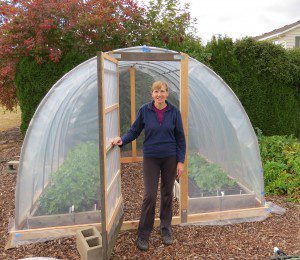Winter gardening Q&A
As you have no doubt heard me say, I love growing veggies through the winter months in our cold climate! I live in Spokane, Wash., in USDA zone 4b/5. It gets very cold here each winter. I found I was really missing having fresh salad greens so I began researching and experimenting with doing this. And, of course, as a gardener, I really wanted to see if I could fool Mother Nature! Winter gardening is great fun.
I’ve shot three videos on this topic so far this fall, which you can find on my YouTube channel(#1, #2 and #3).
However, I often am asked questions about what it involves so thought it would be helpful to do a quick Q&A on growing a winter garden. Here’s what folks are asking me:
“By the end of the regular gardening season, I’m ready for a break. Why would I want to do even more work for months after my garden is put to bed?”
I completely understand how you feel, but the main task of growing a winter garden isharvesting your produce during the fall and winter months. You don’t have to weed, water, prune or mulch.
“When do you start planting?”
When it comes to winter gardening, I start most of my cold-tolerant veggies from seed indoors in late July or the first of August. Those are crops like kale that need a bit of a head start before planting them outdoors about 4-6 weeks later. Some cold-tolerant veggies need to be direct-sowed because they don’t like to be transplanted; I do this in mid- to late August. The seed packets will indicate which sowing method is best.
“Which are the most cold-tolerant crops I can grow in a cold climate such as Spokane?”
Kale (‘Vates’, ‘Winterbor’, ‘Starbor’, ‘Ripbor’ and ‘Redbor’), Claytonia (miner’s lettuce), corn salad (mache) and Minutina. If you’re not familiar with the last 3 — and most folks aren’t — they are easy to grow and really add a lot to salads. I love trying new things and this is the perfect opportunity to do that. Other veggies that will grow until about December include ‘Bordeaux’ spinach, arugula and mizuna.
“Why don’t you have to water the plants? Won’t they get too dry?”
You would think so, but once it starts getting chilly, the soil will retain its moisture and whatever you covered the plants with (floating row cover or plastic) will also help keep the plants hydrated by holding in the water that has been transpired by the plants. I stopped watering my plants in about mid-October this year.
“How do you protect the plants from the cold?”
You can keep this as simple as you want, or get fancy!
Simple method first: I’ve had success with just covering the plants with a sheet of floating row cover at the time we start getting frosts and then as it starts getting a lot colder, I place a sheet of heavy-duty clear plastic over that and it works well. It’s important to use hoops over the bed to hold the plastic and/or floating row cover over the plants. And it’s really important to clip the cover(s) to the hoops so the covers won’t rest directly on the plants which could cause them to become frosted.
I should also mention that the hoops should be sturdy and/or tied together with twine so they won’t collapse during heavy snow. (see photo to right)
The fancy method: Cover the bed(s) with a simple plastic-covered hoop house or use grow beds inside an unheated greenhouse.
If you’re going the plastic sheeting route, make sure it is anchored down so it doesn’t blow off during strong winter winds.
“What types of problems do you encounter with winter gardening? Are there any insects?”
You would think it’d be too cold to have insect problems but I’ve encountered three types of insects over the past two winters. Fortunately, I know how to thwart them!
The first type of insect is slugs (technically gastropods), which can do a lot of damage to plant foliage. Refer to my method for organically eliminating them.
The second type is cabbage worms, which are the larvae of the cabbage butterfly. I know members of the cole or Brassica family (cabbage, broccoli, cauliflower, Brussels sprouts, kale) are susceptible to them. As soon as I plant my kale outdoors in the fall, I cover the bed with a sheet of floating row cover to prevent cabbage butterflies from laying their eggs on the foliage. It works great.
The last type of insect is the leaf miner. The adults are flies. They lay eggs on the leaves of spinach, Swiss chard or beets. Once the eggs hatch, the larvae tunnel through the leaves, ruining the crop very quickly. Covering the bed with a sheet of floating row cover as soon as you plant any of these crops will also resolve this problem.
“What else is involved in winter gardening?”
I recommend checking on your plants once a week, although if you’re harvesting them regularly, that will suffice. You’re mainly just looking to see if there is any insect activity.
“Anything you’ve learned the hard way, that I should know about?”
Yes! Do NOT underestimate the importance of daylight! Make sure your winter veggie bed is in as open an area as possible. Avoid locating it next to a building or under a big tree. Plants need all the light they can get, in order to be successful.
“What winter gardening references would you recommend, so I can read more about this?”
There are three excellent references that you will find very helpful:
- Four-Season Harvest by Eliot Coleman (Chelsea Green Publishing, 1999, 243 pp.)
- The Winter Harvest Handbook by Eliot Coleman (Chelsea Green Publishing, 2009, 248 pp.)
- Year-Round Vegetable Gardener by Niki Jabbour (Storey Publishing, 2011, 248 pp.)

